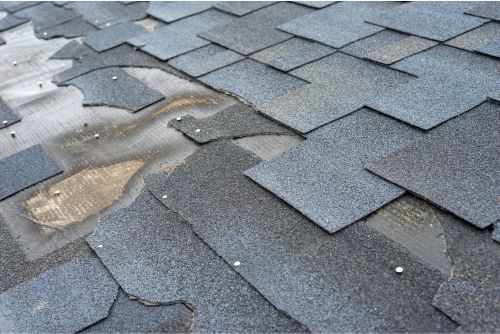A timely stitch saves nine. This applies to your roof. As a homeowner, I often wonder when should you install a new roof. Wear and tear raises the question, but it’s not always an easy choice. This discussion will cover the signs that it’s time for a new roof. We’ll discuss warning signs like leaks, water damage, and cracked or curled shingles.
First, let’s acknowledge the urgency of addressing these issues.
Leaks And Water Damage
Leaks and water damage are common roof issues for homeowners. It’s annoying and can damage your home if ignored. Leaks can let water into your walls, ceilings, and foundation. Mold growth, structural damage, and costly repairs can result.
Roof leaks must be repaired immediately to avoid further damage. Some homeowners try to fix the problem themselves, but a roofing professional is usually best. These professionals can find the leak and offer effective solutions.
Choose a leak detection and repair roofing professional for roof repairs. They’ll inspect your roof thoroughly for problems. Shingles, flashing, and gutters may be damaged. The roofing professional will repair your roof after finding the leak.
In addition to fixing leaks, preventative measures can reduce water damage. Clean gutters and inspect for damage to spot potential issues before they become major ones.
Missing Or Damaged Shingles

After leaks and water damage, homeowners often find missing or damaged roof shingles. This issue must be addressed immediately to prevent roof damage and leaks.
A roof with missing shingles is susceptible to water infiltration and structural damage. However, damaged shingles can leak and cause more water damage inside your home.
Missing or damaged shingles require immediate action. If the damage is severe, you may need roofing repair or replacement. Ignoring the problem can lead to more damage and costly repairs.
A roofing professional must inspect your roof to determine how to replace missing shingles. They’ll replace missing shingles and secure them to prevent future issues. Cracked or curling shingles may be repaired, depending on the damage. In some cases, replacing damaged shingles may be cheaper.
New roofing materials and methods are being developed to give homeowners longer-lasting solutions. These innovative roof replacement options can extend the lifespan and performance of your roof. A roofing professional can help you choose materials and methods that fit your needs and budget.
Aging Roof
Maintenance and repairs are needed as your roof ages due to wear and tear. Age is a key factor in deciding if a roof needs replacing. Roof materials can deteriorate over time, causing issues. To fix problems quickly, you must know the signs of an aging roof.
Cracked or curled shingles are a clear sign of an aging roof. Shingles that no longer protect your home from the elements may leak and cause water damage. Shingle granules in gutters indicate a failing roof.
Mold, or mildew, can form on an old roof. Moisture builds up on deteriorating roofs, making these harmful growths thrive. Mold and mildew weaken the roof and harm you and your family.
Additionally, an aging roof can increase energy costs. As the roof loses insulation, your heating and cooling bills may rise. Roof gaps or cracks let air escape and outside air in. You can install a new roof on your own but you need the right knowledge and skills to do it.
High Energy Bills

If your roof has cracked or curled shingles, mold, or mildew, it may be raising your energy bills. Poor insulation and air leakage in an aging roof can make your heating and cooling systems work harder and use more energy. This hurts your wallet and the environment. Installing a new roof may fix this and lower your energy bills.
Energy-efficient roofing materials are essential when replacing a roof. Modern roofing materials like metal or solar panels can reduce heat absorption and keep your home cooler in hot weather. These materials reflect sunlight and block it from entering your home, reducing air conditioning needs. Installing energy-efficient roofing materials can save you money over time.
Local weather can also affect energy bills. Extreme temperatures, rain, and wind can damage your roof and reduce its insulation. Thus, a roofing material that can withstand local weather and provide optimal insulation is essential.
Hire energy-efficient roofing contractors when installing a new roof. They can help you choose and install the right roofing material to maximize your home’s energy efficiency.
Sagging Or Drooping Roof
My roof is sagging, threatening my home’s structure. Sagging or drooping roofs indicate serious issues that must be addressed immediately. Ignoring this issue could cause more damage and safety risks. A sagging roof requires immediate action to ensure home stability and safety. This is one factor to consider on when should you install a new roof.
First, call a reputable roof repair contractor. They’ll know how to assess the damage and recommend a solution. A sagging roof may be repaired instead of replaced. Your roofing contractor can decide if this is a good option.
However, extensive damage may require a roof replacement. This may seem daunting and expensive, but it’s necessary for your home’s long-term stability and value. Replace the roof to fix the sagging and add protection and energy efficiency.
Remember that aging, poor installation, or water damage can cause a sagging roof. Therefore, to prevent future issues, the root cause must be addressed. Working with a reputable roofing contractor ensures proper and efficient repairs or replacements.
Granules In Gutters

Granules in my gutters suggest roof problems. I investigated further and considered a new roof after this discovery. Granules in gutters indicate roof damage and should be considered. Age and storm damage cause asphalt shingles to lose their protective granules. These granules in gutters indicate roof deterioration and may require replacement.
Granules shield asphalt shingles from harsh weather. They protect shingles from UV rays, regulate temperature, and strengthen the roof. The granules loosen and fall off as the roof ages because the adhesive weakens. Hail and high winds can also dislodge the granules, leaving the asphalt shingles vulnerable to further deterioration.
Take immediate action if your gutters have too many granules. Ignoring this issue could cause leaks, water damage, or structural issues. A professional roofer can assess your roof’s condition and recommend a replacement. They’ll assess granule loss and other damage and recommend a course of action.
Sunlight Coming Through The Roof
Sunlight through the roof may indicate urgent issues. Sunlight through the roof may indicate serious roof repair or replacement. This is especially true if there are multiple sunlit areas, leaks, or water damage.
Sunlight entering the roof indicates gaps in the roofing materials. The roof may be aging or damaged by severe weather. Any source of sunlight through the roof indicates that it is no longer protecting.
Such situations require immediate repair or roof replacement. A roof replacement may be needed if the damage is too extensive to repair. To properly install the new roof, the old roof must be removed.
Choose high-quality roofing materials to prevent future sunlight penetration. Durable, weather-resistant, and properly installed roofing shingles protect against the elements. Regular inspections and maintenance can also spot problems early.
Mold Or Mildew Growth

If sunlight enters the roof, mold and mildew may grow. A roof with sunlight penetration can foster mold and mildew growth in damp, dark environments. Having mold or mildew in your home can cause health issues and structural damage, so it must be addressed immediately.
Mold and mildew growth may require more than just roof repair. An entire roof replacement may be needed to fix the issue. Sunlight may enter a compromised roof, indicating water damage. A professional roofing company can assess the situation and recommend a solution.
Mold and mildew prevention begins with roof maintenance. Regular inspections and repairs can spot issues before they become major. Leaks and discolorations should be addressed immediately.
Innovative roofing materials and methods can also prevent mold and mildew. Some roofing materials are mold- and moisture-resistant. The roof and attic can be kept dry with proper ventilation, reducing mold and mildew growth.
Roof Deck Rotting Or Sagging
Roof deck Rotting or sagging can damage your home’s structure. You must act immediately if you notice rot or sagging in your roof deck to prevent further damage and protect your home. New roofs are often needed in such cases.
When your roof deck rots or sags, the structure may be weakened. This can cause a roof collapse or water leakage, which can damage your property. Your old roof must be replaced to avoid these risks.
An experienced roofing contractor should assess the damage and recommend a roof replacement. They’ll know how to diagnose the rot or sagging and recommend a solution. They’ll also install the new roof properly using industry-standard materials.
A new roof can fix rotting or sagging and improve your home’s energy efficiency and appearance. There are many roofing materials that provide better insulation and durability, improving roof performance and longevity.
Stains On Interior Ceilings Or Walls

Interior ceiling and wall stains are a common problem for homeowners. These stains may indicate a serious issue that needs immediate attention. Here are three reasons why interior ceiling or wall stains may require a new roof:
- Roof Leaks: Stains on interior ceilings or walls are often caused by roof leaks. When the roof is old or damaged, it can develop cracks or holes that allow water to seep through. Over time, this water can cause stains on the interior surfaces of your home. If you notice these stains, it’s a clear sign that your roof may be compromised and in need of replacement.
- Mold and Mildew Growth: Another consequence of a leaking roof is the growth of mold and mildew. When water seeps into your home, it creates a damp environment that’s ideal for the growth of these harmful substances. Not only can mold and mildew cause health issues, but they can also weaken the structural integrity of your home. If you see stains accompanied by a musty odor, it’s crucial to address the issue promptly by installing a new roof.
- Aesthetics and Property Value: Stains on interior ceilings or walls can significantly impact the aesthetics of your home. Whether you plan to sell your property or simply want to maintain a visually appealing living space, a new roof installation can help restore the beauty of your interior. Additionally, a new roof can increase the value of your property, making it a worthwhile investment.
Excessive Roof Repairs
After multiple roof damage incidents, I realized I needed too many roof repairs. I needed repairs every few months for leaks, missing shingles, and wear and tear. Patching the roof wasn’t sustainable, I realized. I considered replacing the roof then.
When should you replace your roof? I considered this question while weighing the pros and cons. Repairs were frequent, indicating my roof was failing. Regular maintenance was costly and time-consuming. It was clear that a new roof was cheaper and more durable.
Shingle condition is a sign of excessive roof repairs. If many shingles are damaged, cracked, or missing, your roof may be beyond repair. The roof may also need to be replaced if it’s nearing the end of its life. Most roofs last 20–25 years, so if yours is older than that, it’s time to replace it.
New roofing materials have also made replacing a roof more appealing. Modern roofing materials like metal, synthetic, and solar shingles are durable, energy-efficient, and attractive. These cutting-edge options improve home security and value.
Increased Noise From Outside

I noticed an increase in outside noise and wondered how it might affect my home’s comfort. Every car, barking dog, and gust of wind seemed to invade my peaceful home. As someone who values quiet, I knew I had to address this issue quickly. Here are three ways outside noise can disturb your home’s peace:
- Disturbed Sleep: The constant noise from outside can make it difficult for you to get a restful night’s sleep. This can lead to fatigue, reduced productivity, and a general feeling of unrest. Installing a new roof can significantly reduce the amount of noise that enters your home, allowing you to sleep peacefully and wake up refreshed.
- Reduced Concentration: Increased noise from outside can also impact your ability to concentrate. Whether you’re working from home, studying, or simply trying to relax, a noisy environment can be highly distracting. By installing a new roof, you can create a quieter and more conducive space for focus and productivity.
- Diminished Comfort: Your home should be a sanctuary where you can unwind and recharge. However, excessive noise from outside can disrupt this sense of comfort and relaxation. Installing a new roof can help create a more peaceful environment, making your home a more enjoyable place to be.
Maintaining a peaceful home requires addressing outside noise. Installing a new roof can reduce external noise and make your home more peaceful.
Cracked Or Curled Shingles
After considering how increased noise from outside could affect my home’s tranquility, I couldn’t ignore cracked or curled shingles’ potential damage. Cracked or curled shingles are unsightly and indicate roof problems. When shingles crack or curl, they’ve reached the end of their lifespan and no longer protect your home.
Broken shingles let water into your roof, causing leaks and damage. This can lead to costly repairs and structural damage if ignored. However, high winds can blow curled shingles off, exposing your roof to more damage.
Take immediate action if your roof has cracked or curled shingles. Ignoring these issues may worsen roof deterioration and costlier repairs. Sometimes, replacing damaged shingles is enough. If a large part of your roof is damaged, you may need a new one.
A new roof improves your home’s durability, safety, and innovation. You can choose from a variety of roofing materials that are more durable, energy-efficient, and attractive thanks to roofing technology. Asphalt shingles, metal, tile, and solar panels are available for every homeowner’s needs.
Roofing Material Deterioration

Roofing materials degrade over time, compromising roof integrity. To prevent further damage and prolong roof life, act quickly when roofing material deteriorates. These signs may indicate roofing material deterioration:
- Cracked or Curled Shingles: Shingles are the first line of defense against the elements, and when they start to crack or curl, it’s a clear indication of deterioration. These damaged shingles can allow water to seep into your roof, leading to leaks and potential structural damage.
- Loss of Granules: Over time, the granules on your shingles may start to wear off. These granules provide protection against UV rays and harsh weather conditions. If you notice granules accumulating in your gutters or missing from the shingles, it’s a sign that your roofing materials are deteriorating and may need replacement.
- Moss or Algae Growth: When your roof becomes a breeding ground for moss or algae, it can indicate a problem with your roofing materials. These growths can trap moisture, leading to further deterioration and potential rotting of the underlying structure.
Regular maintenance and inspections can identify early roofing material deterioration. These issues must be addressed immediately to prevent further damage. Doing nothing about deteriorating roofing materials can lead to costly repairs or roof replacements.
Roof Approaching Its Expected Lifespan
Roofs wear out over time. When a roof nears its expected lifespan, assess its condition and decide if it needs replacing. The lifespan of a roof depends on its material, weather, and maintenance.
Considering replacing your roof if it’s nearing its expected lifespan? Roofs can deteriorate from weathering, causing leaks and other issues. You can protect your home, add value, and improve its appearance by replacing your roof.
Consider your roof’s condition when deciding to replace it. Missing or broken shingles, sagging areas, and ceiling water stains indicate wear and tear. Contact a roofing contractor if you notice any of these issues.
Remember that the lifespan of a roof depends on many factors. Asphalt shingles last 20–30 years, while metal roofs can last 50 years or more. When deciding to replace your roof, consider its durability.
Final Thoughts
In conclusion, if you notice any signs of damage or aging on your roof such as leaks, missing shingles, or high energy bills, it’s time to consider installing a new roof. Don’t ignore the warning signs, as a deteriorating roof can lead to further damage and costly repairs.
By taking proactive steps and replacing your roof when needed, you can ensure the safety and longevity of your home. In this article, you have been presented with facts about when should you install a new roof.
Frequently Asked Questions
Are There Any Safety Precautions To Consider When Installing A New Roof?
Yes, there are several safety precautions to consider when installing a new roof.
First, it’s important to wear proper protective gear, such as a hard hat and safety harness.
Additionally, ensuring a stable and secure ladder is essential to prevent falls. It’s also crucial to be aware of potential hazards, such as electrical wires or weak roof structures. Following safety guidelines and taking necessary precautions will help ensure a successful and accident-free roof installation.
How Long Does The Process Of Installing A New Roof Typically Take?
Typically, the process of installing a new roof takes a few days to a few weeks, depending on the size and complexity of the project.
Factors such as weather conditions, the type of materials being used, and the availability of skilled contractors can also affect the timeline.
It’s important to plan ahead and consider any potential disruptions to your daily routine during the installation process.
Can I Install A New Roof Over My Existing Roof?
I can install a new roof over my existing roof, but it’s not always the best option. It’s important to consider the condition of the existing roof and any potential issues that may arise.
Installing a new roof over an old one can save time and money, but it can also lead to additional weight on the structure and potential problems down the line. It’s best to consult with a professional to determine the best course of action.
What Are The Advantages And Disadvantages Of Different Roofing Materials?
When considering the advantages and disadvantages of different roofing materials, it’s important to weigh factors such as durability, cost, and aesthetic appeal.
Some materials like asphalt shingles offer affordability and easy installation, while others like metal and tile provide greater longevity and resistance to fire and weather damage.
However, each material has its drawbacks, such as the higher price of metal or the fragility of tile. Ultimately, the best choice depends on your specific needs and budget.
How Much Does It Cost To Install A New Roof?
The cost of installing a new roof depends on its size, materials, and upgrades. Long-term benefits like energy efficiency and property value should be considered when replacing a roof. Investing in a new roof may seem expensive, but it will prevent costly repairs and protect your home.

